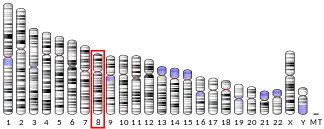TTI2
TELO2 interacting protein 2 is a protein that in humans is encoded by the TTI2 gene. [5]
| TTI2 | |||||||||||||||||||||||||||||||||||||||||||||||||||
|---|---|---|---|---|---|---|---|---|---|---|---|---|---|---|---|---|---|---|---|---|---|---|---|---|---|---|---|---|---|---|---|---|---|---|---|---|---|---|---|---|---|---|---|---|---|---|---|---|---|---|---|
| Identifiers | |||||||||||||||||||||||||||||||||||||||||||||||||||
| Aliases | TTI2, C8orf41, MRT39, TELO2 interacting protein 2 | ||||||||||||||||||||||||||||||||||||||||||||||||||
| External IDs | OMIM: 614426 MGI: 2384576 HomoloGene: 11836 GeneCards: TTI2 | ||||||||||||||||||||||||||||||||||||||||||||||||||
| |||||||||||||||||||||||||||||||||||||||||||||||||||
| |||||||||||||||||||||||||||||||||||||||||||||||||||
| |||||||||||||||||||||||||||||||||||||||||||||||||||
| |||||||||||||||||||||||||||||||||||||||||||||||||||
| Wikidata | |||||||||||||||||||||||||||||||||||||||||||||||||||
| |||||||||||||||||||||||||||||||||||||||||||||||||||
Function
This gene encodes a regulator of the DNA damage response. The protein is a component of the Triple T complex (TTT) which also includes telomere length regulation protein and TELO2 interacting protein 1.
The TTT complex is involved in cellular resistance to DNA damage stresses and may act as a regulator of phosphoinositide-3-kinase-related protein kinase (PIKK) abundance.
References
- GRCh38: Ensembl release 89: ENSG00000129696 - Ensembl, May 2017
- GRCm38: Ensembl release 89: ENSMUSG00000031577 - Ensembl, May 2017
- "Human PubMed Reference:". National Center for Biotechnology Information, U.S. National Library of Medicine.
- "Mouse PubMed Reference:". National Center for Biotechnology Information, U.S. National Library of Medicine.
- "Entrez Gene: TELO2 interacting protein 2". Retrieved 2016-12-14.
Further reading
- Hurov KE, Cotta-Ramusino C, Elledge SJ (2010). "A genetic screen identifies the Triple T complex required for DNA damage signaling and ATM and ATR stability". Genes Dev. 24 (17): 1939–50. doi:10.1101/gad.1934210. PMC 2932975. PMID 20810650.
This article incorporates text from the United States National Library of Medicine, which is in the public domain.
This article is issued from Wikipedia. The text is licensed under Creative Commons - Attribution - Sharealike. Additional terms may apply for the media files.



